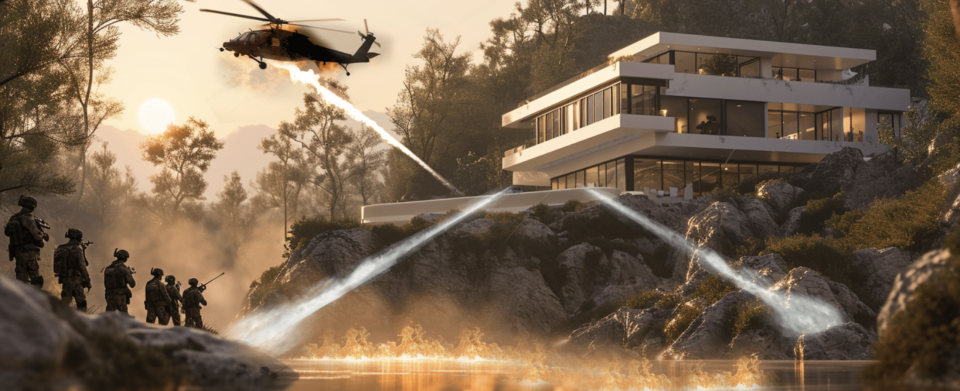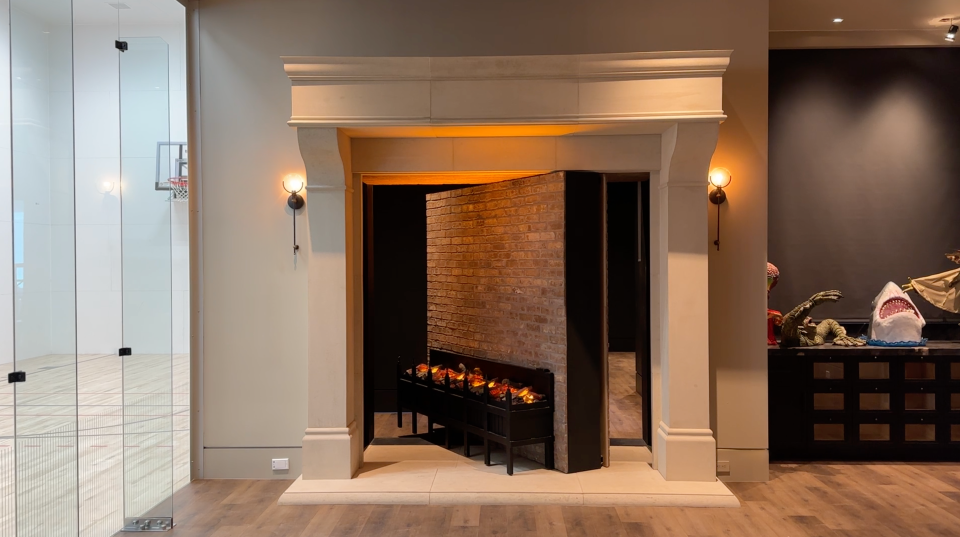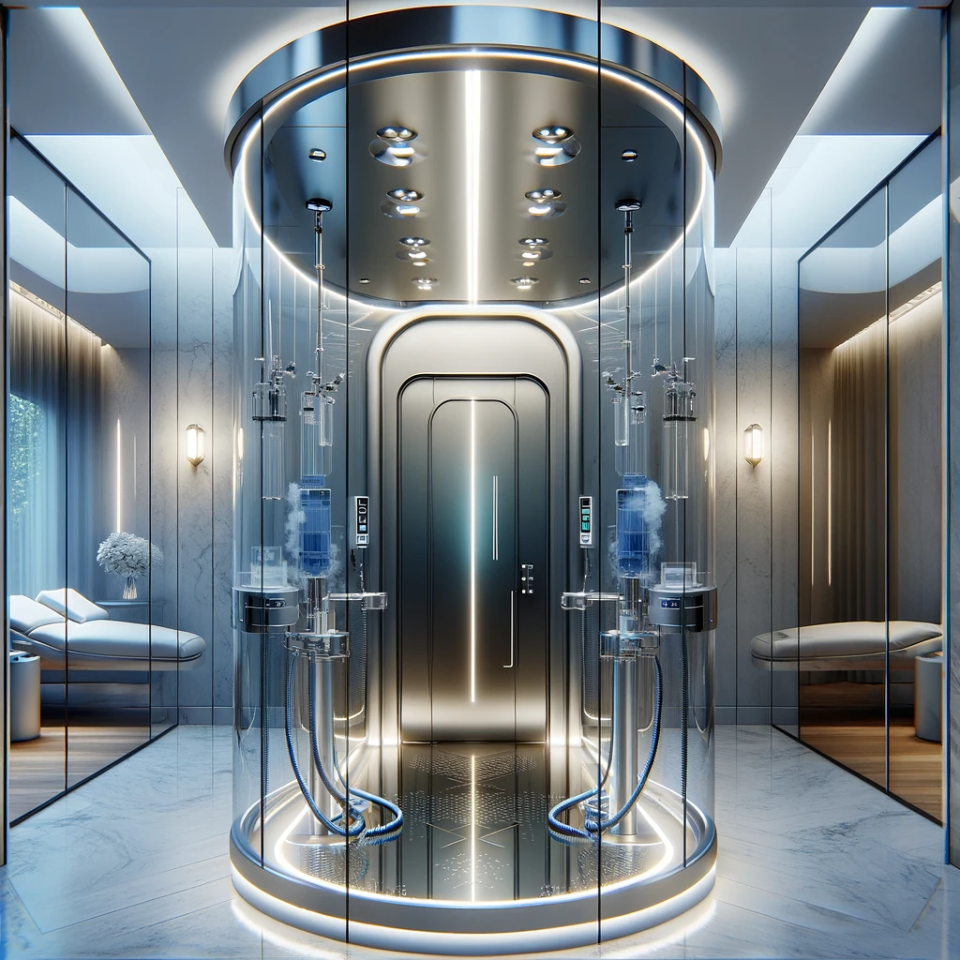Billionaires’ Survivalist Bunkers Go Absolutely Bonkers With Fiery Moats and Water Cannons

On the heels of Sam Esmail’s apocalyptic thriller Leave the World Behind and December news reports that Mark Zuckerberg is constructing a 5,000-square-foot bunker under his ranch on the island of Kauai, the business of fortified shelters is booming.
Adding more fuel to the flames: escalating armed conflict around the globe and, closer to home, the ongoing onslaught of mass shootings and an increasingly fractious political landscape leading up to the presidential election on Nov. 5.
More from The Hollywood Reporter
Streaming Ratings: 'Reacher' Still Big in Second- Season Debut
Streaming Ratings: 'Young Sheldon,' 'Super Mario Bros. Movie' Reap the Netflix Effect
'Leave the World Behind' Director Sam Esmail Explains His Controversial Ending
The one-percenters who can afford to pull out all the stops for self-preservation are doing so more than ever — often in a fashion that goes way beyond the submerged corrugated metal units seen on reality shows like Nat Geo’s Doomsday Preppers.
Aiming to protect themselves from potential threats including civil unrest, cyberattacks, nuclear bombing, power grid failure and drastic climate-change events, many work directly with general contractors to build kitted-out end-times bunkers, while others call on a handful of specialized companies.
“It got really busy, and it seems like the phone hasn’t stopped ringing; World War III seems like it’s coming,” shares Ron Hubbard, CEO of Texas-based Atlas Survival Shelters, who notes that the news about Zuckerberg’s bunker “caused a buying frenzy.” He’s currently constructing a $7.5 million bunker for a client in Oklahoma that is in the design phase.

Robert Vicino, founder of Del Mar, California-based Vivos, which creates underground survival shelters, agrees: “Now that Zuckerberg has let the cat out of the bag, that’s got other people who share his status or are near his status starting to think, ‘Oh God, if he’s doing that, maybe he knows something that I don’t, maybe I should seek this out myself.’ But it’s no secret that the one-percenters and top-ranking government officials have been in on this bunker idea for a long-ass time. The pandemic was a huge driver of interest in sales; then all the global concerns and issues at home are another boost. We’re here to provide peace-of-mind solutions.” Other moguls enamored by bunkers include billionaire and former Paypal CEO Peter Thiel — whose attempts to build one in New Zealand were nixed in 2022 — and Bill Gates who is rumored to have underground security areas under every one of his homes.
Al Corbi, president and founder of Virginia-based SAFE (Strategically Armored & Fortified Environments), which caters to custom designs for the uber-rich, notes that many billionaires are particularly focused on how to survive power grid failures, including buying cars and planes that are less reliant on computer interfaces. “A lot of these guys are buying up King Air or older planes that don’t have the electronic avionics, and keeping one or two older cars built before 1986 in their collection, so they’ll still function in an EMP [electromagnetic pulse]. The newness is it’s shifting from the idea of nuclear ka-boom to protection against local threats. The real threat is the power grid, which is ironically the plot of Leave The World Behind. In situations like this, sustaining your life is as important as food and water.”
The average shelter that Hubbard sells “on a daily basis” — consisting of a prefab modular steel bunker — is in the $200,000 to $400,000 range (“It’s like buying a Ferrari,” he says) and 50 percent of Atlas Survival Shelters clients are women. (Hubbard appeared on an episode of the final season of Keeping Up With The Kardashians in 2021 in which Kim and Khloé Kardashian tested out one of his 500-square-foot, $200,000 bunkers.)

Due to global demand, bunker air filtration systems (which run $3,000-$10,000) are becoming scarce, says Hubbard, so he bought up 711 of them in December (more than he has purchased in the past 13 years combined) to keep up with growing clamor. He says that the company is currently working with two billionaire customers in the U.S., “both related to Facebook,” but their bunkers cap out below $500,000.
At the highest end, “I hear there are a couple of big bunkers being built in the United States in the $5 to $10 million range,” adds Hubbard, who is currently constructing a $5 million bunker for a client in Kuala Lumpur, Malaysia, that will also house his car collection.
Corbi — who worked on the palatial 27-floor, $4.8 billion Mumbai residence of business mogul Mukesh Ambani of Reliance Industries — reveals to THR that his most spectacular project, due to be completed in 2025, is an island fortress created on a 200-acre property in the U.S., with cutting-edge tactical systems.
“The shelter can withstand a blast one mile from ground zero,” says Corbi. “But that was almost incidental. The client [a business mogul] was saying, ‘I want to make sure that no one can get to my family,’ so we wound up literally building a 30-foot-deep lake [around the compound] skimmed with a lighter-than-water flammable liquid that can transform into a ring of fire. The only access to the island is a swing bridge.”
Also at Corbi’s project, “there are water cannons that can take down parachuters, Apache helicopters, whatever’s coming your way 500 feet in the air,” he says. “Then we took all the dirt removed for the lake to literally build a mountain as natural fortification around the property. And we cut a tunnel through with flame-throwers, gassing systems, a steel wall that closes midway that could stop a 16-wheeler going 80 miles an hour, and bollards at both ends.”

The bells and whistles actually can double as everyday fun. According to Corbi, friends of the owner might enjoy a flag football game on jet skis, dodging the water cannons’ ability to lock in and blow them off the skis, creating “a mind-boggling adult Nintendo game, a wild entertainment factor,” he describes, adding that the cannons can also blow rainbows into the air as a backdrop to a barbecue or create rainfall on a sunny day. The site preparation alone cost millions of dollars, “a fraction of the cost of the overall project,” says Corbi, who sees a trend of clients with existing bunkers requesting add-on tactical defense components to the tune of about a million dollars to upgrade.
The next-level question becomes where to go if something somehow happens to the primary shelter. Elaborate tunnels systems that route people to alternate bunkers offer a backup plan, plus “all types of extraction devices and systems, but that really isn’t something I can talk about; let’s just say, on all the super-yachts, there are helicopters and submarines,” says Corbi.
Fueled by the pandemic and clients with existing medical conditions, SAFE has partnered with Virginia medical consulting company Vital RN, founded by Corbi’s wife Naomi, a registered nurse, to offer state-of-the-art decontaminant booths, medical supplies and rooms with full operating tables in bunkers.

“We installed one on Long Island, and you feel like you are in the best-equipped Cedars-Sinai or Cleveland Clinic operating room!” says Corbi. “You can have every drug imaginable that you could possibly need locked in cabinets that can only be opened remotely by a physician, so it’s all within the confines of the law.”
When it comes to secret passageways and hidden doors, many turn to Arizona-based Creative Home Engineering, where a door can cost more than $50,000 a pop. “I’m wrapping a project for a client in the Phoenix area that includes nine secret doors that didn’t spare any expense,” says Creative Home Engineering president Steve Humble. “He has an underground shooting range accessed by this massive fireplace that rotates like the one in Indiana Jones and the Last Crusade. Then there’s a giant staircase that raises up to reveal a big basement, where a vehicle elevator goes down to the garage. We also installed a British phone booth. When you dial 867-5309 on the receiver, the song plays and the glass turns opaque so you disappear; then the back wall opens up and there is actually a slide that takes you two levels down where there’s a flight simulator, and a sensor causes the back panel of the booth to return and the glass goes transparent, so nobody can understand how you got out of there. The house also happens to have a giant shark tank in the basement that shares one wall with the swimming pool, so it looks like you are swimming with sharks. And the pool is more like a water park, with a flow river, a lazy river, a grotto and a glass bottom, so you can see a go-cart track underneath the pool. This guy’s got all the toys! He has a safe room and we did one secret door that’s exclusively for security, but the rest is mostly just for showing off.”

Yet Humble says that the majority of his approximately 100 current custom and standard projects are focused on security. “In cities like L.A., the homeless-slash-crime epidemic getting out of control seems to be a recurring theme lately, so people are getting serious about security,” he says. “I have a project in Colorado with nine ballistic, armored pocket doors, because they need to be able to lock down the house at any time. I’m also doing security vault doors for several famous people.” (Notably, violent crime in Los Angeles declined by double-digit percentages in 2023 compared to the previous year.)
In January, Creative Home Engineering released a new off-the-shelf Vault Mirror Secret Door, that appears to be a full-length mirror, for just $6,000. “That’s about the same price as a regular vault door, but this one has camouflage,” he says. “A lot of famous people make the mistake of having a safe, which is almost like having a neon sign in your house that says, ‘This is where I keep my valuables.’ So people break in and know where to focus their efforts, using basic tools like a crowbar. Until now, if you wanted a secret door that was also a bulletproof vault door for forced entry protection, it was a custom job that cost about $20,000, so this is an exciting development.”

Another client called on Creative Home Engineering to build “an underground museum in his basement involving multiple secret doors to access the room and inner sanctum,” says Humble, to securely store a collection of extremely rare cards (worth about $250,000 each), with the designs on the cards ornately carved in the display cabinetry.
Mike Peters, owner of Utah-based Ultimate Bunker (which also does business in Nevada and California) has found a niche in safe rooms that start at around $50,000 for an 8-foot by 8-foot space with an additional $30,000 for every window. The safe rooms’ electric and bulletproof doors open with a key fob or a fingerprint. “A lot of people in Hollywood have had their homes broken into, so they need somewhere to go in the middle of the night right by their bedroom or to put their whole bedroom on lockdown,” says Peters, noting that his bunker business is also booked out for well over a year. “We can fortify any room, and we’ve got people who want to be able to pull their car in the garage and run inside and have peace of mind, if somebody is on their tail.”
In the security business, privacy is paramount, but there are always exceptions.
“In 50 years, we’ve never had a client harmed or their possessions compromised, so we pick our clients as much as they pick us,” says Corbi. “I was called for an initial consultation with the builder who was working on Brad Pitt and Jennifer Aniston’s house back when they were together, and I did a risk assessment of the property. If you could have seen what their builder was building — it was so bad that I had to turn the job down. I’m not exaggerating. Where the roof comes down and touches the floor, he built a wall along that, so they had to get down on their hands and knees and crawl the whole length of it and jump almost a story down into the lawn and run over to the neighbor’s house. You would have to have been a rat on adrenaline for that thing to work!”

Best of The Hollywood Reporter

 Yahoo News
Yahoo News 
